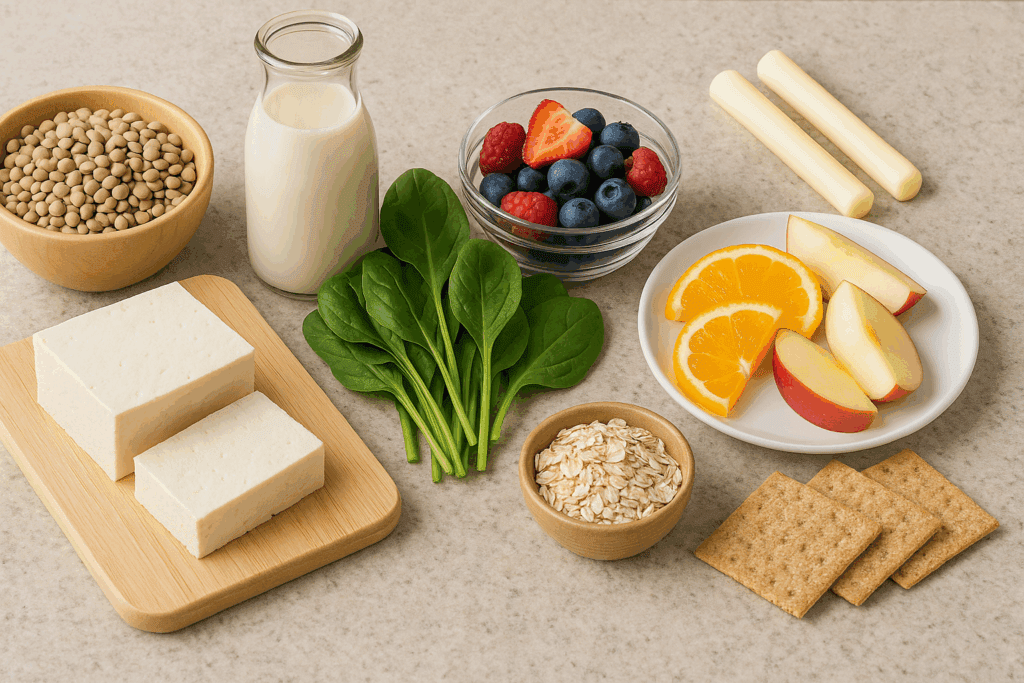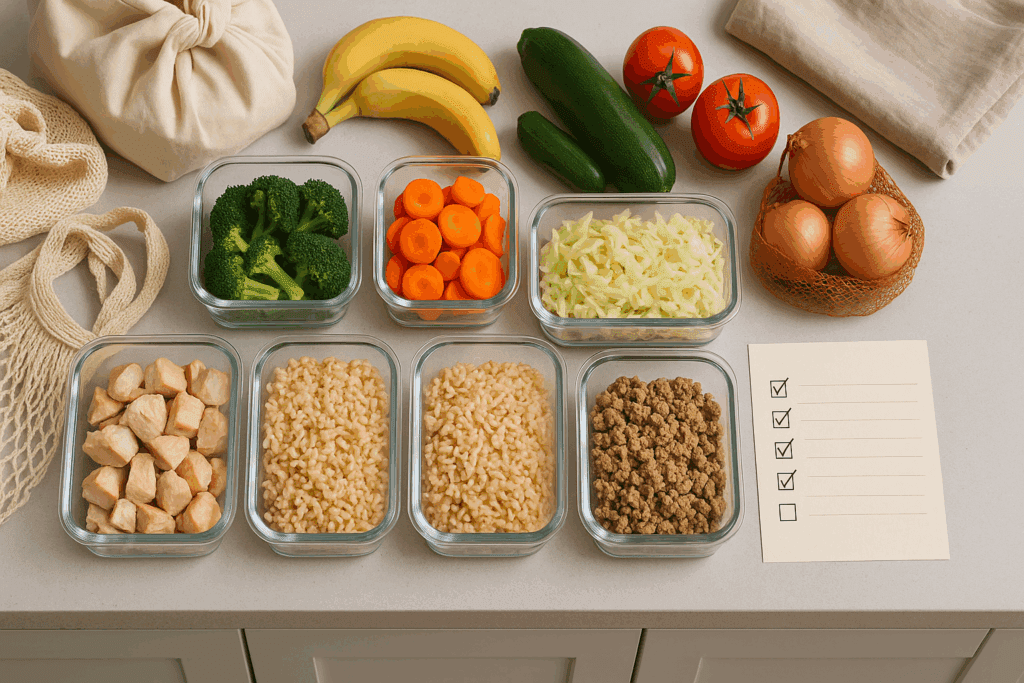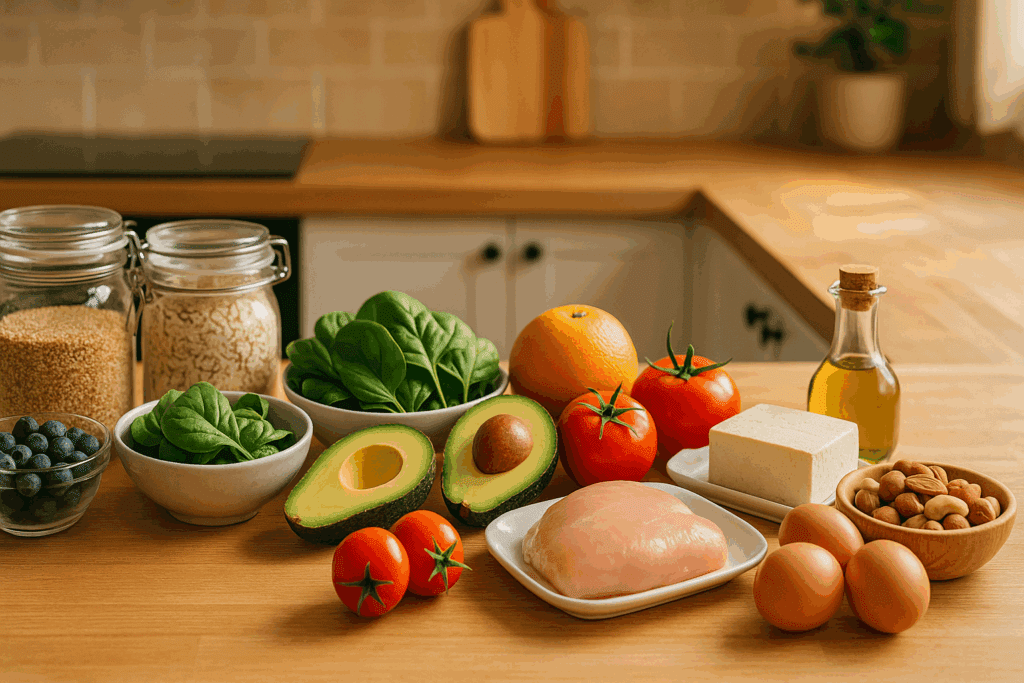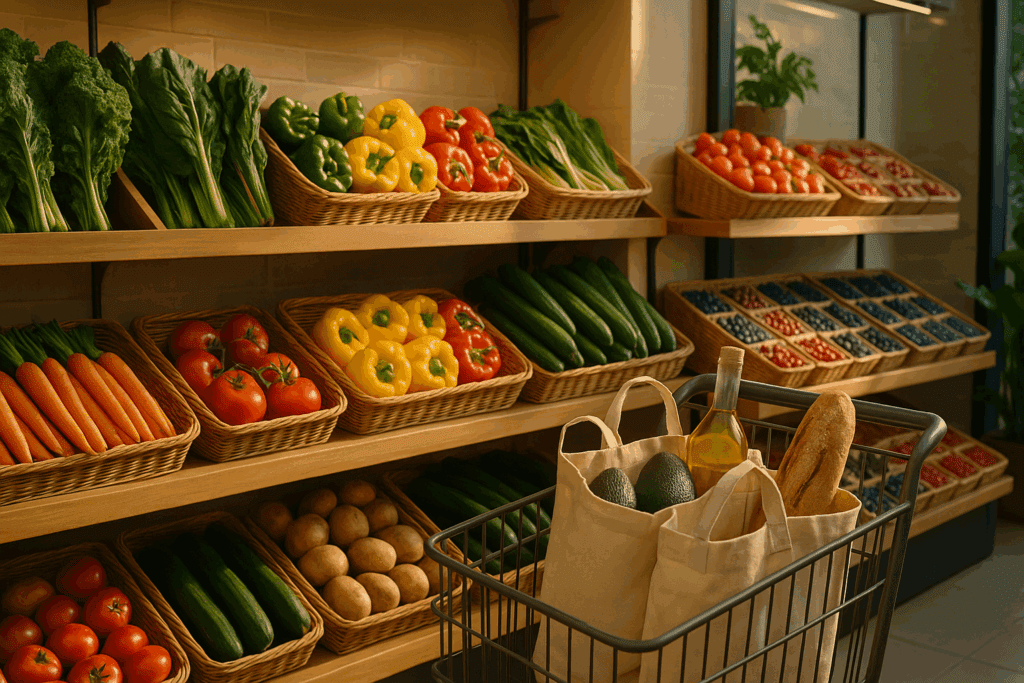Introduction: Rethinking the Way We Grocery Shop
Grocery shopping is more than a routine chore; it is a foundational step in achieving and maintaining a healthy lifestyle. With increasing awareness about nutrition and wellness, a growing number of consumers are seeking expert-backed strategies to build a healthy food list grocery shoppers can rely on for optimal nourishment. Yet, despite this interest, many still find themselves overwhelmed by product choices, confusing labels, and the ever-present temptations of ultra-processed convenience foods. The need for a practical, science-informed approach to creating a healthy grocery list has never been more urgent.
You may also like: 4 Ways to Have a Healthy Diet: Expert Tips Backed by Science for Better Nutrition and Long-Term Wellness
This guide empowers readers with actionable knowledge rooted in both nutrition science and behavioral strategies. It explores how to create a normal grocery list that aligns with dietary needs, health goals, and lifestyle preferences without compromising on flavor or satisfaction. Whether you are a health-conscious parent, a college student learning to shop independently, or a busy professional striving to eat better, this comprehensive shopping list for the supermarket will help you take control of your nutrition from the grocery cart to the kitchen table. With a combination of expert insights and real-world examples, you’ll learn not only what to buy when grocery shopping but why certain choices support sustained well-being.
The Anatomy of a Basic Grocery List: Building the Foundation for Health
A good grocery list begins with clarity of purpose. Rather than approaching shopping reactively, a structured, basic grocery list provides the framework needed to ensure that each item serves a functional, nutritional, or culinary role in your meals. At its core, a healthy grocery list grocery strategy includes nutrient-dense items from key food groups such as vegetables, fruits, whole grains, lean proteins, and healthy fats. While these categories may seem familiar, the difference lies in intentionality: selecting whole, minimally processed versions that offer the greatest nutritional return.
Whole grains like oats, quinoa, and brown rice are grocery essentials not just because of their fiber content but also due to their stabilizing effect on blood sugar levels. Similarly, fruits and vegetables, particularly those that are colorful and seasonal, contribute antioxidants, phytonutrients, and fiber that collectively reduce inflammation and promote gut health. Proteins, whether animal-based or plant-derived, are central to a balanced diet and should be included in every essential food shopping list. Lean meats, legumes, tofu, and dairy alternatives each serve diverse dietary needs and preferences.
The best food shopping checklist incorporates flexibility without sacrificing structure. This means leaving room for personalization and variety while maintaining a commitment to whole foods. Spices, herbs, and healthy oils may seem like small additions, but they play a critical role in enhancing flavor and reducing reliance on sodium and sugar. Ultimately, a basic shopping list that supports long-term health is one that is not only nutritionally robust but also practical, affordable, and adaptable.

Healthy Grocery Shopping List Essentials by Category
One of the most effective ways to ensure that your food shop list is comprehensive is to organize it by category. This method not only saves time but also improves dietary balance by encouraging a wide range of nutrients. For example, produce should take center stage in your grocery store shopping list. Prioritize dark leafy greens, cruciferous vegetables, berries, citrus fruits, and colorful peppers. These items are rich in vitamins, minerals, and antioxidants that support immunity, heart health, and brain function.
In the protein section, focus on high-quality sources like skinless poultry, eggs, Greek yogurt, beans, lentils, and fatty fish such as salmon or sardines. These not only support muscle repair and metabolic function but also offer essential nutrients like B vitamins and omega-3 fatty acids. Whole grain options should include low-glycemic choices such as barley, millet, and sprouted grain bread to sustain energy throughout the day. The dairy aisle, often a point of confusion, should emphasize unsweetened plant-based milks, plain yogurts, and cheeses in moderation.
Don’t overlook pantry staples when creating your essential grocery list. Items such as canned beans, tomato paste, low-sodium broth, and frozen vegetables are invaluable for busy days when time is limited. Healthy fats like olive oil, avocado oil, and seeds also belong in every healthy grocery shopping list, as they contribute to satiety and cardiovascular health. Having a well-balanced array of ingredients in your kitchen makes it easier to prepare nourishing meals on a consistent basis.

What to Buy When Grocery Shopping: Strategic Choices for Better Outcomes
Understanding what to buy when grocery shopping starts with recognizing which items serve your long-term goals versus those that provide only fleeting gratification. The most helpful grocery list includes foods that offer lasting energy, support healthy digestion, and stabilize mood. Nutritional density should guide your decision-making process, with emphasis on foods that deliver high vitamin, mineral, and fiber content per calorie.
Avoiding the central aisles of the supermarket, where processed snacks and sugary cereals dominate, is a common tactic used by dietitians. Instead, focus your attention on the perimeter of the store, where fresh produce, meats, and dairy products are typically located. Stock up on ingredients that can form the base of multiple meals—such as a carton of eggs, a bag of spinach, or a container of hummus—to maximize utility and reduce waste. These versatile items serve as cornerstones of a good grocery list.
Also, pay attention to nutrition labels when browsing items. Even those marketed as healthy groceries can contain excessive added sugars, refined grains, or preservatives. Take the time to compare products, looking not only at calorie counts but also at fiber, protein, and ingredient quality. Smart food shopping essentials reflect not only what is nutritious but what is practical, budget-conscious, and suited to your specific lifestyle.
From Planning to Plate: How to Use a Food Shopping Checklist Effectively
Having a food shopping checklist is only half the battle; how you implement it makes all the difference. Begin by planning meals around what you already have, and then identify what is missing to complete the week’s menu. This proactive method prevents overbuying and ensures your list for grocery store runs is both efficient and intentional. It also helps reduce food waste, an increasingly important aspect of sustainable living.
As you shop, group similar items together in your cart to stay organized and reduce impulse buys. For example, place all produce together, followed by proteins, grains, and dairy. This physical organization mirrors your shopping list suggestions and makes it easier to verify that you’ve met your nutritional goals. If shopping with others—such as a partner or children—assign each person a category to speed up the process and foster healthy eating habits as a shared responsibility.
Post-shopping, store your items properly to preserve freshness. Wash and prep produce in advance, portion out snacks into single servings, and cook staple grains or proteins in batches. A well-thought-out healthy food grocery shopping strategy doesn’t end at checkout; it extends into how you store, prepare, and consume your groceries throughout the week. Proper planning transforms your great shopping list into a reliable roadmap for balanced eating.

Shopping List Suggestions for Special Diets and Needs
Every shopper has unique needs, and tailoring your shopping list ideas to specific health goals or dietary restrictions is a key part of success. For instance, individuals following a plant-based diet might prioritize legumes, tofu, fortified plant milks, and whole grains like quinoa or farro. Their essential grocery list will also include B12-fortified foods and diverse fruits and vegetables to ensure nutrient variety.
For those managing diabetes or prediabetes, a healthy grocery shopping list will emphasize low-glycemic foods such as leafy greens, berries, lentils, and whole oats. These items help regulate blood sugar and support steady energy. Similarly, those focused on heart health should look for foods low in sodium and saturated fats, with plenty of fiber-rich choices like beans, barley, and unsalted nuts. Incorporating omega-3 rich fish and cooking oils like olive or flaxseed also supports cardiovascular function.
Families with children can benefit from a kid-friendly grocery list example that balances fun with nutrition. Choose whole-grain versions of favorite snacks, natural peanut butter, string cheese, fresh fruits, and cut veggies with dips. Having these options readily available helps cultivate healthy food preferences from a young age. Whether your goal is weight management, athletic performance, or chronic disease prevention, adjusting your food shop list to meet these needs ensures that your grocery shopping remains relevant and effective.
The Psychology of Grocery Shopping: Staying Focused and Informed
Navigating the modern grocery store isn’t just a physical task—it’s also a psychological one. Bright packaging, strategic product placement, and in-store promotions are designed to influence our choices, often steering us toward less healthy items. Understanding the psychology of shopping can strengthen your resolve and help you stick to your food shopping checklist more consistently.
One key strategy is to never shop hungry. Hunger impairs decision-making and increases the likelihood of impulse purchases, which tend to be calorie-dense and nutrient-poor. Shopping with a healthy grocery foods list in hand keeps your focus on long-term benefits rather than short-term cravings. Consider framing your shopping trip as a mindful practice, where each item you select represents a choice for your well-being.
Using technology can also enhance your experience. Apps that generate grocery list suggestions based on your health goals or dietary preferences help reduce friction in planning. Some even sync with recipes or meal plans, creating a seamless link between intention and action. When your good grocery list is reinforced by digital tools and grounded in expert advice, it becomes easier to resist distractions and make choices that align with your health vision.

Grocery Shopping Essentials for Long-Term Wellness
Health is not achieved in a single meal but through consistent patterns over time. Your grocery shopping essentials should reflect this long-term mindset by including ingredients that support a diverse, whole-food diet. Staples like canned legumes, frozen berries, whole grain pasta, and extra-virgin olive oil are pantry heroes that make healthy cooking easy and enjoyable.
Stocking up on fermented foods such as yogurt, kimchi, or miso can also boost gut health by enhancing microbial diversity. Meanwhile, keeping a rotating selection of herbs and spices—such as turmeric, cumin, garlic, and basil—adds both flavor and anti-inflammatory properties to meals. These simple but powerful additions help you transform a normal grocery list into a personalized toolkit for better living.
Seasonal shopping can further enrich your experience. Local produce is often fresher, more flavorful, and less expensive when purchased in season. Visiting farmers markets or participating in community-supported agriculture (CSA) programs exposes you to new foods that diversify your nutrient intake. Such practices encourage mindful consumption and create a stronger connection between food, place, and health.

Frequently Asked Questions: Advanced Grocery Shopping Guide for Healthy Living
1. How can psychological habits impact your grocery store shopping list choices?
Psychological habits play a significant role in shaping your grocery store shopping list. Emotional triggers, such as stress or nostalgia, often lead to impulse purchases that are not part of your essential grocery list. For instance, if you associate certain snacks with comfort, you might unintentionally prioritize them over healthy grocery foods. To maintain a helpful grocery list that aligns with wellness goals, try using mindfulness techniques like journaling cravings or reflecting on your mood before shopping. Over time, this strategy can help reinforce a grocery shopping essentials mindset that supports both physical and emotional health.
2. What strategies help bridge the gap between a healthy food list grocery and budget constraints?
Balancing a healthy food list grocery with financial limitations is achievable through strategic planning. First, build your essential food shopping list around nutrient-dense but low-cost staples like oats, beans, canned fish, and frozen vegetables. These offer longevity in storage and versatility in meal prep. Next, consult a grocery list example tailored to budget-friendly superfoods; this keeps your food shop list both affordable and nutritious. Additionally, focus on in-season produce and store-brand items, which often mirror the quality of name brands. When done right, even a basic grocery list can evolve into a cost-efficient, healthy grocery shopping list.
3. What to buy when grocery shopping to future-proof your pantry for emergencies?
To future-proof your pantry, your list for grocery store runs should include long-lasting, shelf-stable healthy groceries. Dried lentils, nut butters, quinoa, and canned salmon are nutrient-rich items that rarely expire quickly and contribute to a healthy food list for grocery shopping. Vacuum-sealed vegetables and dehydrated fruits are also excellent additions to your essential grocery list, especially when fresh produce is scarce. Including electrolyte drinks and fortified cereals ensures your food shopping checklist remains nutritionally balanced in uncertain times. Planning your grocery list grocery with resilience in mind promotes both preparedness and wellness.
4. How do social influences affect your basic shopping list decisions?
Social circles subtly shape your shopping list ideas. Peer preferences, cultural traditions, and trending diets on social media often dictate what ends up on your food shopping essentials list. For example, if your friends are embracing plant-based eating, you may subconsciously alter your grocery list suggestions to include more legumes and meat substitutes. To maintain nutritional integrity, cross-reference these trends with expert-backed shopping list suggestions from registered dietitians. A healthy grocery shopping list should reflect your unique goals while integrating insights from your community in a conscious and balanced way.
5. How does seasonality enhance a good grocery list?
Creating a good grocery list with seasonal items maximizes both flavor and cost-effectiveness. Fresh produce harvested in-season is not only cheaper but also richer in nutrients due to shorter storage times. For example, building your essential food shopping list around fall vegetables like squash or spring fruits like strawberries ensures you’re getting optimal value. Your shopping list for supermarket trips can rotate seasonally, offering natural variety and excitement to meal planning. Over time, your healthy food grocery shopping strategy will become more dynamic and enjoyable while supporting local agriculture.
6. What role does label literacy play in building a healthy grocery shopping list?
Understanding food labels is key when selecting healthy groceries. For example, items marketed as “low-fat” may compensate with high sugar content, which undermines a well-planned food shopping checklist. Learning to read ingredient lists and serving sizes enables smarter decisions, especially when building your grocery store shopping list around whole foods. Include a mix of verified organic and minimally processed items on your healthy food list grocery to avoid hidden additives. Over time, this empowers your basic shopping list to reflect not only taste preferences but also evidence-based nutrition.
7. How can a digital grocery list example improve shopping efficiency and reduce food waste?
Digital tools make it easy to organize your grocery list grocery while reducing redundancy and waste. Apps can suggest shopping list ideas based on your eating habits and track pantry inventory to prevent overbuying. A synced food shopping checklist between family members also reduces miscommunication and duplicate purchases. By digitalizing your essential grocery list, you can build more intentional habits around healthy grocery foods and budget management. These platforms often allow you to tag items by expiration date, streamlining your grocery shopping essentials process.
8. What are advanced tips for creating a healthy food list for grocery shopping with food sensitivities?
If you have food sensitivities, crafting a grocery list suggestions sheet that accommodates restrictions without sacrificing nutrition is vital. Focus your healthy groceries selection on whole, single-ingredient items like gluten-free grains, nut milks, and anti-inflammatory herbs. For protein, your essential grocery list can include allergen-friendly sources like hemp seeds or wild rice. Look for grocery list example templates from trusted health professionals tailored to conditions such as IBS or dairy intolerance. With preparation, your food shop list can be both symptom-safe and nutritionally comprehensive.
9. How can color-coding your list for grocery store visits boost nutritional diversity?
Color-coding your helpful grocery list by food group or produce color can ensure a balanced intake of essential nutrients. For example, assigning green to leafy vegetables and red to berries can remind you to diversify your healthy food grocery shopping haul. This visual strategy also appeals to children and partners who may be involved in the food shopping checklist. Over time, it nurtures an intuitive sense of balance when scanning your grocery essentials. Whether you’re creating a basic grocery list or a more advanced menu planner, this tactic makes healthy eating more engaging and effective.
10. What are the long-term health benefits of refining your grocery list suggestions regularly?
A static list can limit nutritional growth, while evolving grocery list suggestions expose you to new micronutrients, textures, and flavors. Regularly reassessing your grocery list example allows you to align it with current wellness goals or dietary needs, such as reducing inflammation or supporting cognitive health. Including different items on your essential food shopping list—like sea vegetables or fermented foods—can enhance gut health and immune function. It also prevents palate fatigue, making your healthy grocery shopping list feel fresh and sustainable. Treat your food shop list as a living document that matures with your health journey.

Conclusion: How to Eat Healthy Food Shopping Guide for Real-Life Results
The journey toward healthier eating begins not in the kitchen, but in the grocery store. Armed with a carefully curated healthy food list grocery shoppers can trust, individuals can transform their eating habits one purchase at a time. By integrating foundational principles with modern tools, a thoughtful grocery list grocery plan becomes a proactive act of self-care, shaping not only what we eat but how we live.
Using a basic shopping list tailored to your health goals makes nutritious eating more accessible and less overwhelming. Whether you’re crafting a food shopping checklist for your weekly meal prep, seeking new shopping list ideas to support a dietary shift, or simply refining your grocery store shopping list to include more healthy groceries, the right preparation is key. Consistency, education, and intentionality are the pillars that turn your helpful grocery list into a lifelong strategy.
Ultimately, healthy grocery foods are not about deprivation but about empowerment. They enable you to nourish your body, support your mental clarity, and align your actions with your values. With every supermarket visit guided by an essential grocery list, you invest in your well-being, one thoughtful choice at a time. This expert-backed, essential food shopping list is more than a tool—it’s your daily compass for balanced, vibrant, and purposeful living.
Further Reading:
Essential Grocery List (How to stock your fridge and pantry)


